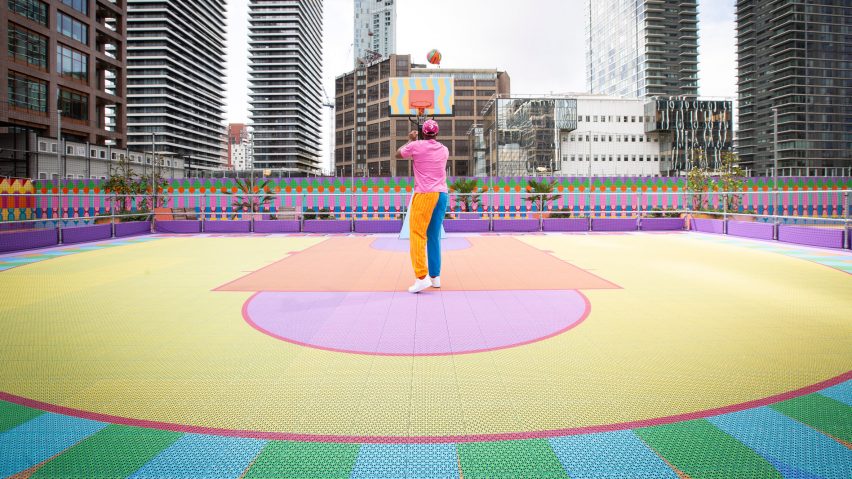Local designer Yinka Ilori has created vibrant patterns for the first public basketball court in Canary Wharf, London's financial district, which features a 3D-printed floor.
The half-sized court is squeezed into a small lot in Bank Street Park and designed for three-a-side basketball, which sees both teams shoot into a single hoop.
Unlike the hardwood or concrete floors typically used for the sport, Ilori's court is covered in 3D-printed polypropylene tiles produced by Hampshire company OnCourt.
This allows the designer's kaleidoscopic court markings, which feature his hallmark geometric motifs, to be embedded into the material itself rather than just being painted on top. The technique is meant to ensure greater durability.
"The colours used on the court are very vibrant and I think they will last a long time," Ilori told Dezeen.
"It's still a sports court so there will be wear and tear but I think the colour and material will keep. People already started using it over the weekend but it's still in good condition so I think that's one of the key benefits."
Called Traction², the flooring is "the first fully machine-printed sports tile surface in the world" and provides greater traction while reducing stress on players' knee and ankle joints, according to OnCourt.
Printed around the edge of the court in bold, uppercase letters is the slogan: "Be the best you can be".
This was chosen to make players of any level feel welcome and assuage any guilt they might have about not staying active after a year of being stuck inside due to continual coronavirus lockdowns.
"I didn't want people to put too much pressure on themselves and instead just celebrate being alive and being around family and friends because not everyone made it through the year," Ilori explained.
"It was about trying to inject this sense of hope and positivity into the space. All you can do is give your best – I think that applies to everything that we do in our lives."
Ilori's colourful prints also spill out onto a wall of hoarding that runs along the perimeter of the court, while a pattern of blue and orange waves laps the backboard of the court's sole basketball hoop.
This recurring aquatic imagery speaks to the deeper connection with nature – and water in particular – that the designer has developed since the start of the pandemic.
"During lockdown, I spent a lot of time going to different forests, parks and canals," he said.
"I just find being around water quite calming so it's a reoccurring theme in the projects I'm doing this year."
The court is open to the public and basketballs will be provided free of charge to encourage its use by the general public, while tournaments are planned for later this summer.
To Ilori, who has previously applied his joyous, colourful style to a skate park in Lille and a South London railway bridge, the project is evidence of a renewed focus on public spaces in the wake of the pandemic.
"We went through a whole year of not going to museums or galleries," he said.
"But having your work in public spaces makes it accessible to everyone – every race and every culture. No matter how much money you have, you can access art in the public space because it's free. So that's why I think what they're doing at Canary Wharf is super important."
Although originally designed as a second home for London's financial sector, Canary Wharf is now home to more than 75 public artworks by 50 different artists, including Camille Walala's Adams Plaza Bridge mural.
This forms part of a wider push to give a new sense of life and personality to an area that has historically been described as a "weekend ghost town", designed for work rather than play.
Photography is by Matt Alexander and Sean Pollock.

